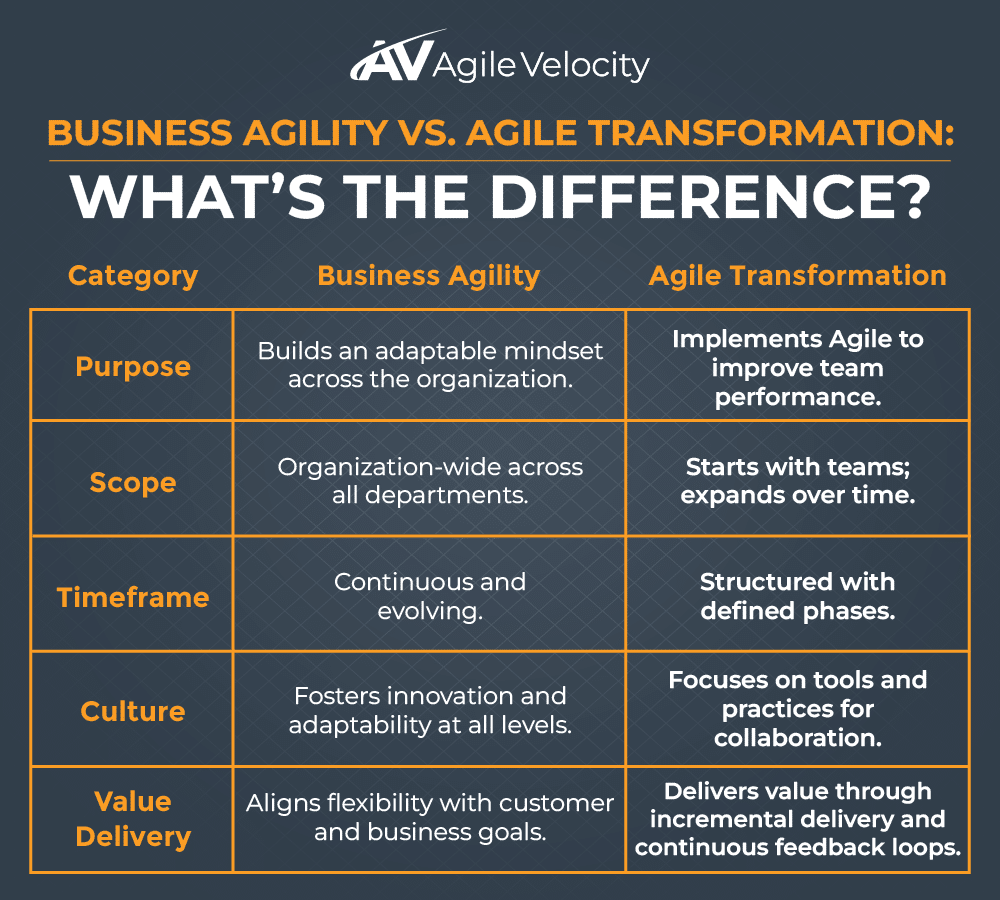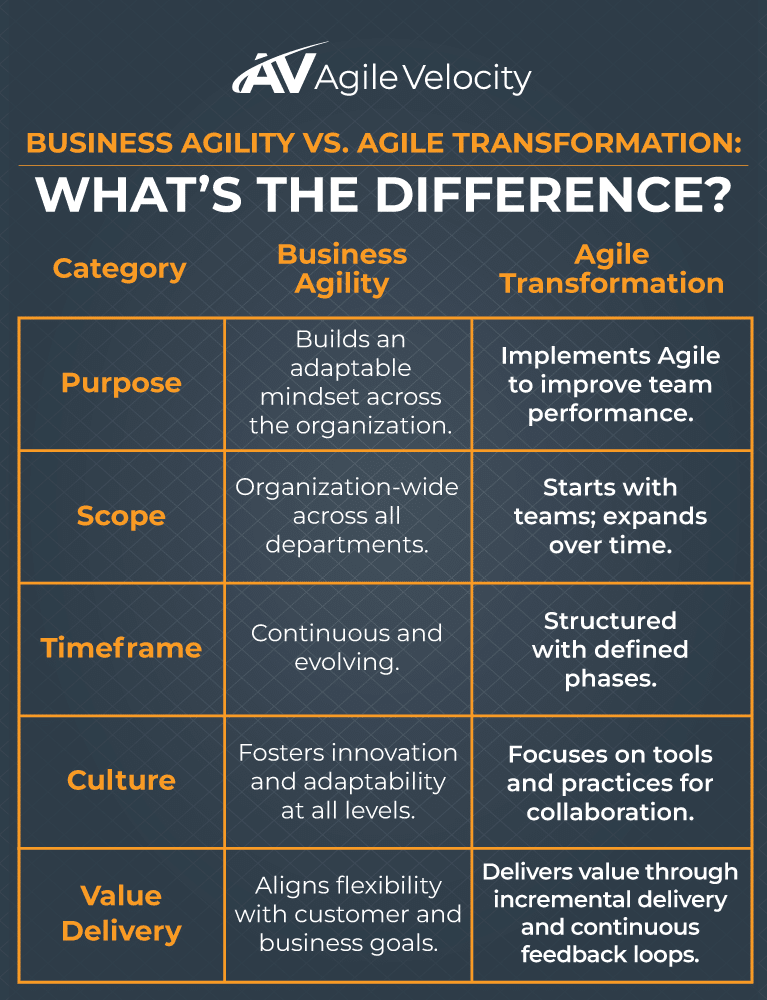In today’s dynamic and fast-paced business landscape, organizations must be flexible, innovative, and resilient. Two foundational strategies that enable these capabilities are Business Agility and Agile Transformation. Although they are often mentioned together, they address different aspects of how organizations adapt and improve. Business Agility focuses on cultivating a mindset and operational capability to respond swiftly to changes, while Agile Transformation involves the systematic adoption of Agile practices—using frameworks like Scrum, Scaled Agile Framework® (SAFe®), or Kanban—to improve collaboration, speed, and efficiency.
This article defines each concept, highlights their differences, and explains how they can be integrated to drive sustainable success.
What Is Business Agility?
Business Agility is an organization’s ability to sense change in the market, customer needs, or internal challenges and respond quickly without maintaining momentum. It goes beyond merely applying Agile practices—it requires a cultural shift that embeds adaptability across all functions. In a competitive landscape, companies that achieve Business Agility often outperform peers by being more responsive and innovative.
Core Principles
- Responsiveness: Constantly monitoring changes and adapting quickly.
- Customer Focus: Making decisions with a clear aim to deliver maximum value.
- Flexibility: Empowering teams with lightweight processes for rapid decision-making.
- Innovation: Encouraging creative thinking and learning from both successes and failures.
Culture of Continuous Improvement
A central tenet of Business Agility is a culture of continuous improvement. Organizations that embrace this approach see long-term benefits as they adjust to evolving market demands. This culture is built on practices that include ongoing Agile support and structured feedback mechanisms.. Companies invest in training programs to ensure that adaptability becomes part of every team member’s daily routine. This focus not only boosts efficiency but also fosters an environment where innovative ideas can thrive without fear of failure.
Organizational Alignment and Strategic Responsiveness
Achieving Business Agility means aligning the core strategies of an organization with rapid decision-making processes. This involves refining practices at every level—from executive leadership to frontline teams—and ensuring all departments align around a shared strategic vision. Transparent communication channels and data-driven decisions help prioritize customer value and operational excellence.
What Is Agile Transformation?

Agile Transformation is the intentional process of embedding Agile practices and principles throughout an organization. It goes beyond isolated training sessions and requires a comprehensive reimagining of workflows, leadership behaviors, and team dynamics to foster a more iterative, collaborative, and adaptive working environment.
Core Components
- Framework Adoption: Implementing Agile frameworks such as Scrum, Kanban, or SAFe to establish structured, iterative cycles that enhance visibility and predictability . For example, in Scrum, teams work in Sprints with events such as Sprint Planning, Daily Scrum, Sprint Review, and Sprint Retrospective to drive progress.
- Leadership Alignment: Ensuring that leaders provide continuous support to remove obstacles and reinforce Agile values.
- Cultural Shift: Beyond frameworks and tools, Agile Transformation emphasizes a broad cultural change. Organizations work to cultivate values of openness, transparency, and continuous feedback.
- Tools and Processes: Leveraging technology—such as collaboration platforms—to streamline workflows and sustain momentum.
- Coaching and Training: Ongoing support helps teams adopt and maintain new practices effectively.
Phased and Measurable Approach
Agile Transformation often unfolds through clearly defined phases. Organizations often begin with pilot teams to experiment with Agile practices, then scale successful approaches across the enterprise.. This incremental approach allows leaders to measure progress against specific milestones, ensuring that the transformation is guided by realistic objectives supported by regular evaluations.
Key Differences Between Business Agility and Agile Transformation
Although interrelated, these two approaches differ in several ways:
Purpose
- Business Agility: Focuses on developing an adaptable mindset across the entire organization.
- Agile Transformation: Emphasizes the implementation of Agile frameworks and practices to enhance team performance.
Scope
- Business Agility: Encompasses all departments and functions, ensuring broad organizational alignment.
- Agile Transformation: Often starts with specific teams or departments and expands as processes prove successful.
Timeframe
- Business Agility: An ongoing, evolutionary journey with no fixed endpoint.
- Agile Transformation: A structured, phase-driven process with defined milestones and measurable checkpoints.
Cultural Emphasis
- Business Agility: Cultivates a pervasive culture of adaptability and innovation that influences decision-making at every level.
- Agile Transformation: Focuses on adopting specific practices and tools that support collaborative workflows and iterative improvement.
Role in Value Delivery
- Business Agility: Ensures alignment with customer value and strategic objectives by integrating flexibility into all operations.
- Agile Transformation: Enhances value delivery on a tactical level through iterative improvements, frequent reviews, and actionable feedback loops.
The Benefits of Combining Business Agility and Agile Transformation
Integrating Business Agility with Agile Transformation provides a powerful advantage by enhancing both operational resilience and market responsiveness.
Accelerated Value Delivery
By integrating a structured Agile approach with an enterprise-wide culture of adaptability, organizations can accelerate value delivery. Agile frameworks provide structured cycles and checkpoints for iterative work, while an Agile mindset empowers teams to adapt as conditions evolve. Additionally, adopting practices like Lean Portfolio Management helps leaders better align projects with strategic priorities.
Enhanced Adaptability and Resilience
The concrete processes of Agile Transformation, when merged with a culture of continuous improvement, bolster overall adaptability. This dual strategy equips organizations to handle both gradual market shifts and significant disruptions, creating an environment where ongoing improvement reinforces everyday learning.
Streamlined Collaboration
Both approaches emphasize the importance of breaking down silos within organizations. Agile Transformation promotes collaboration through cross-functional teams, while Business Agility nurtures a shared cultural focus on common objectives. Together, they foster more effective communication and collective decision-making.
Long-Term Resilience
A combined focus on a continuous improvement mindset and structured transformation processes establishes long-term resilience. Organizations can respond quickly to disruptions and leverage change as an opportunity for innovation and growth.
Overcoming Challenges in Achieving Both
Implementing a combined strategy of Business Agility and Agile Transformation comes with its own set of challenges. Recognizing and addressing these challenges is key to success.
Resistance to Change
Employees accustomed to traditional methods may resist new ways of working. Organizations should invest in comprehensive training and maintain open dialogue to emphasize the benefits of change. Sharing real-world examples of improved outcomes can help reassure teams.
Misaligned Leadership
Successful transformation requires strong leadership alignment. Differing views on Agile values or inconsistent engagement from top executives can hinder progress. Facilitated leadership workshops and regular strategic discussions can help secure a unified direction.
Functional Silos
Isolated departments with differing goals can impede transformation efforts. Encouraging cross-functional collaboration through joint planning and shared accountability helps integrate and align various parts of the organization.
Lack of Clear Objectives
Without defined, measurable goals, tracking transformation progress becomes challenging. Organizations should establish quantifiable metrics—such as time-to-market improvements and customer satisfaction levels—to gauge success and adjust strategies accordingly.
Over-Control from Executives
While executive oversight is essential, micromanagement can stifle team autonomy and innovation. Executives need to strike a balance between providing guidance and allowing teams the autonomy to experiment and innovate.
Measuring Success: Metrics and Key Performance Indicators
Accurately measuring success is vital for both Agile Transformation and Business Agility. Key Performance Indicators (KPIs) help organizations track progress and ensure that the transformation is delivering the intended value.
Common Metrics for Agile Transformation
- Cycle Time: The period from initiating a task to its completion. Monitoring cycle time helps reveal process bottlenecks.
- Sprint Velocity: Measures how much work a team delivers within each Sprint, helping forecast future capacity. Insights into Sprint Velocity aid in capacity planning and process improvement.
- Defect Density: The ratio of defects relative to delivered work, indicating product quality.
- Team Satisfaction: Regular surveys assess team morale and overall work environment health. Team Satisfaction provides insights into how well Agile practices are supported.
Metrics for Business Agility
- Customer Satisfaction Scores: How well products and services meet market demands.
- Time-to-Market: Shorter delivery cycles signal greater market responsiveness.
- Employee Engagement: High engagement levels indicate a dynamic, innovative culture.
- Market Responsiveness: The speed at which an organization adjusts its offerings to meet changing market conditions.
A balanced scorecard that combines these KPIs allows leaders to make informed, adaptive decisions that keep the transformation on track.
Enhancing Leadership and Organizational Support

Leadership is a critical enabler of both Business Agility and Agile Transformation, shaping the conditions for sustainable change.
Leadership Best Practices
- Modeling Agile Values: Leaders should exemplify adaptability , openness and a willingness to learn from outcomes.
- Regular Communication: Sharing updates ensures that everyone understands the transformation’s objectives.
- Empowerment: Delegating decision-making authority enables teams to respond promptly.
- Continuous Learning: Leaders who pursue ongoing training reinforce the importance of continuous improvement.
Organizational Structures that Support Agility
- Decentralized Decision-Making: Empowering cross-functional teams reduces bureaucratic bottlenecks.
- Collaborative Workspaces: Designing environments that encourage real-time communication aids agility.
- Feedback Mechanisms: Regular reflection sessions help teams adapt and refine their practices.
- Outside Expertise: Many organizations engage business operations consulting to identify structural improvements and expedite cross-functional collaboration.
Enterprises across industries—including technology, finance, and healthcare—have successfully blended Business Agility and Agile Transformation to improve responsiveness and drive innovation. Several companies have reported benefits such as faster value delivery, improved customer satisfaction, and better operational efficiency by adopting smaller, cross-functional teams and iterative development practices.
Leveraging Path to Agility® Navigator to Bridge the Gap
Path to Agility® Navigator simplifies the journey toward both Agile Transformation and Business Agility. The tool integrates data from across teams to present a clear snapshot of an organization’s current status and highlights areas for improvement. Its features include:
- Identifying Areas for Improvement: Pinpoint misalignments and prioritize next steps.
- Tracking Progress: Deliver real-time insights into transformation initiatives.
- Offering Actionable Guidance: Recommend targeted actions based on assessed maturity levels.
- Supporting Scalability: Provide consistency that can be extended across multiple departments.
Building a Culture of Continuous Improvement to Sustain Results
Sustained success requires embedding continuous improvement into the organizational culture. This demands a steadfast commitment to learning, adapting, and evolving.
Strategies to Foster Continuous Improvement
- Promote Transparent Communication: Open dialogue ensures that challenges are promptly addressed.
- Encourage Experimentation: Pilot new ideas on a small scale before broader implementation.
- Nurture Cross-Departmental Collaboration: Sharing lessons learned strengthens overall organizational unity.
- Celebrate Successes and Learn from Setbacks: Recognizing wins builds morale, while setbacks become valuable learning opportunities.
- Incorporate Routine Reflection: Regular retrospectives or business reviews help maintain focus on long-term improvement.
By embedding these practices into daily operations, organizations can ensure that the benefits of Agile Transformation and Business Agility endure over time.
Which Path Will Unlock Greater Agility for Your Business?

Business Agility and Agile Transformation are distinct yet mutually reinforcing approaches. Agile Transformation provides structured, iterative methods for improvement, while Business Agility cultivates a flexible mindset geared toward sustained responsiveness. Together, they enable organizations to innovate effectively, accelerate value delivery, and maintain resilience in a constantly evolving business landscape.
Leaders who understand these differences can design strategies that integrate structured processes with a dynamic culture of learning. Organizations are advised to explore tools like the Path to Agility® Navigator and consult with experienced professionals to tailor an approach that meets their unique needs. In doing so, they can better position themselves to unlock significant potential and build an enterprise that is truly future-ready.





